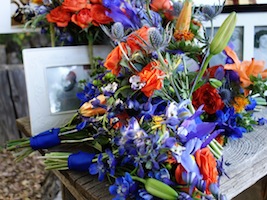Search Results for “”
Delphinium and Larkspur Send a Message of Heroism
The statuesque delphinium is easily recognizable for its tall spike of five-petaled flowers. One of the birth flowers for July, these flowers are named for the Latin word for dolphin and their history goes back several thousand years. Continue reading [...]
5 Whimsical Wildflowers for your Wedding Bouquet
Adding a bit of nature to your nuptials is easy with the choice of fresh flowers for your bouquet, ceremony and reception area. While your area florist will have a wide variety of beautiful, tropical flowers imported from all over the world, using more native-looking and natural wildflowers can lend a unique look to your special day. Here are five choices that will give any bouquet a fresh-picked look.
Larkspur
Native to parts of North America, this frilly flower comes in some of the truest Continue reading [...]
Funeral Flowers: How to Express Sympathy, Send Condolences and Offer Solace
Flowers express so many feelings, and funeral flowers can be chosen to show respect for the deceased while also offering support, concern and love for the bereaved. Carefully-chosen funeral floral arrangements can help to ease some of the pain at the visitation and during the service; and it's always appropriate to send flowers even some time after the service, to show the bereaved that you're thinking of them, that you care for them, and you understand that loss takes time to come to terms with. But which flowers send appropriate messages at such a difficult time? Continue reading [...]
July Flowers
This flower guide for the month of July gives you the meaning of flowers (larkspur flowers are the birth month flowers for July. An alternative July birthday flower is the water lily). Read on to discover what message you're sending when you include these flowers in a bouquet for some who has a birthday in July. Continue reading [...]


